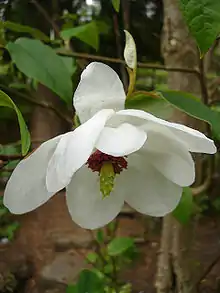Magnolia wilsonii
Magnolia wilsonii, or Wilson's magnolia, is a species of Magnolia native to China, in the provinces of western Guizhou, Sichuan and northern Yunnan, where it grows in the forest understory at altitudes of 1,900-3,000 m, rarely up to 3,300 m.
| Magnolia wilsonii | |
|---|---|
 | |
| Flower | |
| Scientific classification | |
| Kingdom: | Plantae |
| Clade: | Tracheophytes |
| Clade: | Angiosperms |
| Clade: | Magnoliids |
| Order: | Magnoliales |
| Family: | Magnoliaceae |
| Genus: | Magnolia |
| Subgenus: | Magnolia subg. Magnolia |
| Section: | Magnolia sect. Rhytidospermum |
| Subsection: | Magnolia subsect. Oyama |
| Species: | M. wilsonii |
| Binomial name | |
| Magnolia wilsonii (Finet & Gagnepain) Rehder | |
Description
Magnolia wilsonii is a large spreading shrub or small tree growing to 8–10 metres (26–33 ft) tall. The leaves are elliptic to lanceolate, 6–16 cm long and 3–7 cm broad with a 1–3 cm petiole, and have brown pubescence on the underside. The flowers are drooping, 8–12 cm in diameter, with nine (occasionally 12) tepals, the outer three small and greenish, sepal-like, the main six larger and pure white; the stamens and carpels are crimson. Due to their drooping character, the flowers are best viewed from the underside.
This species is threatened by habitat destruction and collection for medicinal use (see Houpu magnolia), and regeneration is poor.
Cultivation
Magnolia wilsonii, though rare, is in cultivation as an ornamental tree and planted in temperate climate gardens, such as in coastal California. It needs a protected planting location with afternoon shade. This plant has gained the Royal Horticultural Society's Award of Garden Merit.[2]
References
- China Expert Workshop. 2015. Magnolia wilsonii. The IUCN Red List of Threatened Species 2015. Downloaded on 8 October 2015.
- "Magnolia wilsonii AGM". Royal Horticultural Society. 2017. Retrieved 2017-01-27.
